President's Message
Fellow woodworkers,
Finishing (coloring and varnishing) has never been my strong point, and I suspect many woodworkers would say the same thing. At our Woodworking Show at Woodcraft earlier this year several of the comments from our judges were in the vain of "finish needs to be better".
I recently had a simple job: clean up and apply a coat of finish to a few of blocks of wood, including 2 blocks of Cocobola.
Cocobola, which I found out after trying to finish them with de-wax shellac and wipe-on poly, is very oily. When I rubbed it down with 180 grit sandpaper and the grit clogged with oil almost instantly. After some research I ended up wiping the surfaces with acetone just before applying the shellac.
It was while working on these blocks I was told that my sanding technique was all wrong – "should not do the early sanding with the grain, use a circular motion to prevent deep lines in the surface; only do the final sanding of the wood with the grain."
The appearance of the finish, gloss or satin etc., is dependent on how much light scatters when it bounces off the surface.
"The deepper the scratches in a finish, the more the light is scattered and the lower the sheen. The shallower the scratch, the more clearly an image is reflected back and the higher the sheen."
In addition I was told the more random (not al in the same direction) the scratches the more they hide defects in the finish.
So if you do not want a high sheen finish you can sand in a circular motion and hide finishing defects.
I am sure you all know this.. I should have, but somehow missed that point.
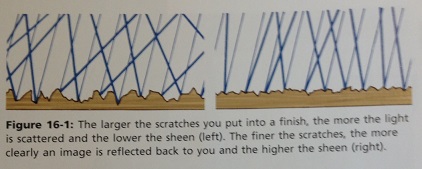
From the Bob Flexner book.
I went back to a book on finishing I bought a few years ago "Understanding Wood Finishing" by Bob Flexner that I bought when I was trying to color Oak to give it a rich Rosewood color for a project I was working on at the time. My reading paid off as eventually I was able to produce the color I wanted by using a series of yellow, then red, then blue stains, but by the time I got that far I had some other work to do so I never got around to reading the Finishing chapter in the book.
We are starting to put together our program for 2019 and are hoping to include some sessions related to finishing.
If you have any suggestions for topics you would like us to try and arrange for next year's meetings or training seminars etc please send me an email so we and add it to our list of topics to consider.
We have added a new occasional item at the end of our Newsletter: "A Blast From The Past" in which Jon Kaplan will dig into our archive of old Newsletters that go back to 1982 to remind us of some past moments in our history.
Below is the first of the series from our our December 1988 Newsletter.
Enjoy your woodworking.
Frank (Contact at: Frankramsay8@aol.com)
Anuual Members Meeting
Frank Ramsay called the meeting to order promptly at 6:00 pm explaining that the BAWA Board had met earlier to review the club's finances, to consider officers for the next year and to seek suggestions for programs in the coming year.
Financial Report: Treasurer, John Blackmore
The club realized revenues of $4,450 in 2018, $2449 in dues from 47 members and $1447 from donations and the Silent Auction.
Expenses totaled $3,875 for the year, room rental of $1320, honoraria of $1,400, and the insurance payment of $671. Only $65 was spent on the wood show. The club had a surplus of $575 for the year.
BAWA has $6,503 in the bank.
The club is budgeting for 54 members in 2019, revenue of $3,542 and expenses of $4,558. Donations for the Silent Auction can help make up the shortfall.
BAWA Election 2018/2019
The following officers were nominated and elected by membership:
President: Frank Ramsay
Vice President: Jay Perrine
Secretary: Steve Rosenblum
Treasurer: John Blackmore
Membership: Bruce Powell
Newsletter: Jon Kaplan
Programe Director: Vacant
Frank noted that until we find a Program Director, the club is performing this function by committee.
End of Annual Members Meeting.
New Members and Guests:
New Member: Shawn Williams joined the club and hails from Brisbane where he is a chocolate entrepreneur. He is interested in learning sharpening and cutting dovetails.
Announcements:
Calender:
December Meeting: The guest speaker is Chris Weiss and he will talk about natural edge slab furniture. He has a trove of slab treasurers.
Silent Auction: Richard Winslow has donated several boxes of board cut-off to the Silent Auction. Each piece is priced at $1. By the end of the meeting, members had contributed $40 to the club.
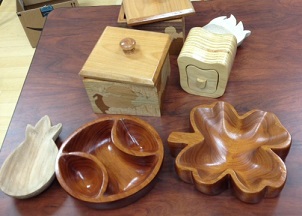
Stan Booker needs veneer donations to give to Montero School shop, examples of their work above.
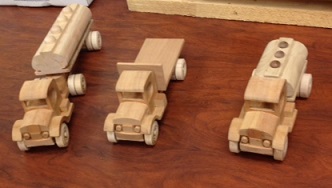
Harry Filer showed some the toys made by at BAWA Toy Workshops.
Larry White will talk about his career as a woodworker including his time with Sam Maloof.

Jon Kaplan toured the Sam Maloof studio earlier this year and met Larry White, whom he invited to speak at a BAWA meeting. Larry's daughter lives in Berkeley and studies at Cal, so he graciously accepted the invitation.
Jon introduced Larry to the membership.
As Larry explains it, he joined Sam Maloof as an apprentice shortly after the lava cooled in California. He worked with Sam off and on for 29 years. He started sanding with Sam in 1962. Then in 1969 until 1976 he lectured at Cal State in Fullerton. In 1976 he moved to Santa Cruz and taught at UC Santa Cruz until 1990. He returned to SoCal in 1990 and rejoined Sam Maloof as an assistant in 1992 where he made furniture and helped Sam prepare for the move of his house and business to Alta Loma, necessitate by the construction of the 210 Freeway.
Larry calls himself a sculptor, artist, and ceramicist who works in wood. Larry was mentored by Sam Maloof. When Larry joined Sam, he worked with Mike Johnson, another apprentice. By 1967 there were four apprentices working with Sam. Sam's creative period was the 1950's, the production period was the 1960's and 70's. He was influenced by the mid century modern work coming out of Scandinavia.
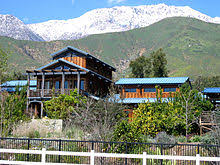
Maloof Heritage Site
As the 210 Freeway was being build, Sam had to relocate his "heritage site" home and business to Alta Loma. Larry also lived on site and had a clay and model studio there. It did not conflict with his daytime wood work with Sam. Larry built a model of the proposed new Maloof home on a 5 x 9 foot panel for Sam's approval. The model became the tool from which the architect did his drawings.
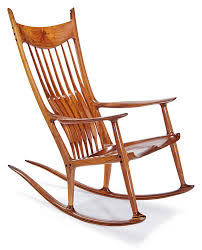
Maloof rocker
Larry showed us several photos of furniture pieces he worked on with the Maloof business. The Maloof rocker would take 3 ½ weeks to build. It was priced at $25,000. Larry made a zircote version of the rocker. The low back dining room chair was made and perfected over a period of 40 years. A chair could be built in 2 ½ weeks, each one made individually. Sam received his walnut from Kevin Taylor out of Chico.
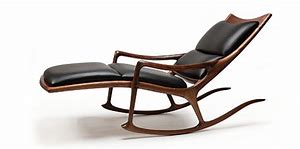
Maloof Chaise Lounge
At the age of 92, Sam started work on a chaise lounge. Larry and Mike helped him complete it. It was finished with a mixture of linseed oil, tung oil and varnish. Rockler sold the Maloof finish for several years, but now because of California's VOX regulations, Larry mixes his own.
The cradle takes 6 weeks to build.
Between 2006 and 2016, Larry had eye problems that have since been resolved with cataract surgery and corneal transplants. During his impaired vision period, Larry worked extensively in drawings and paintings using broad brush strokes and textures in paper.
Sam died in 2009 and Larry has continued working with the Maloof Foundation, and with Sam Maloof Woodworker, Inc. He is offering 3-day workshops and one-day classes for up to four students. The objective is for the student to make one Maloof furniture piece. Classes begin in January.
Larry also has a veterans project. Five veterans make the templates and fixtures, then mill the wood to make a Maloof inspired project. It gets them away from their worries.
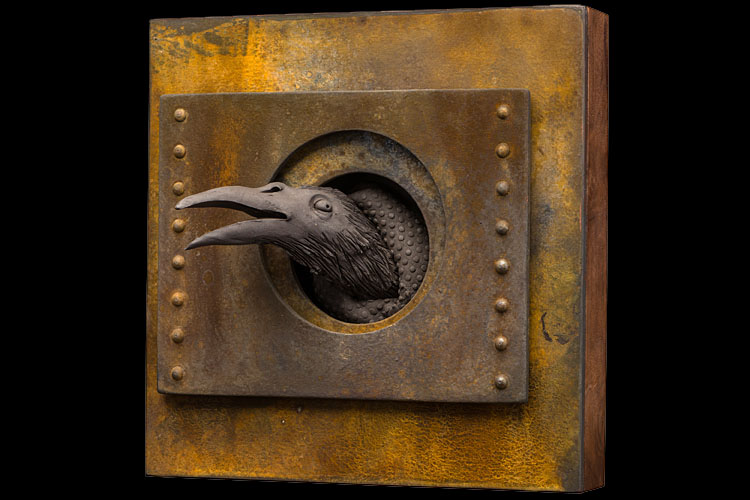
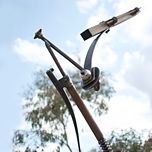
Two of Larry's artworks
Now Larry has his own studio in Pioneertown in the high California desert. He has hired an assistant and he is mentoring her, just as he was by Sam. Lauren too works for the Foundation. She is a quick learner and is already designing and building her own furniture. The tradition continues and we thank Larry for the fascinating presentation.
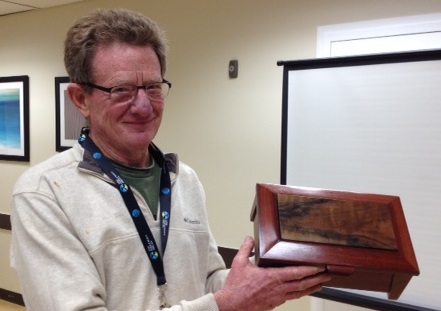
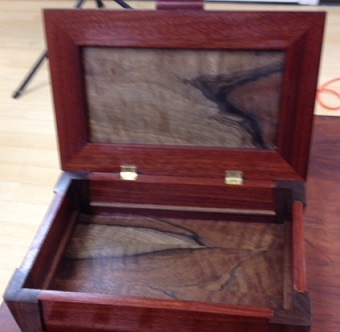
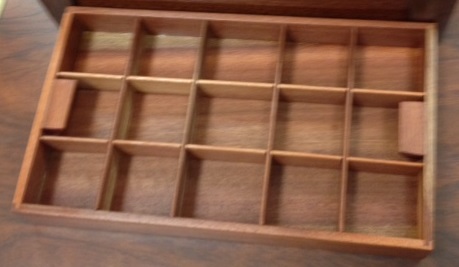
John Blackmore made a jewelry box of Macacuada and Bastone Walnut. It is the first of a planned production of 17 units, each a little different in wood selection. He plans to give them away as gifts.

Ed Schoenstein showed us a 3 foot model he made of The Tower of the Sun that was built for the SF World's Fair held on Treasure Island. The 80th anniversary of the Fair will be held in April 2019. The museum would like to build a large replica for the event. Ed asked if BAWA might want to take it on as a charitable project. (Ed's finger is pointing to the scale fingers at the entrance to the tower.)
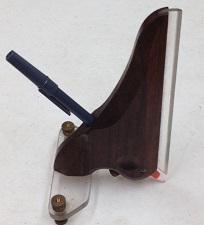
DH Mayeron showed a vertical scriber he attributed to Alan Doer.
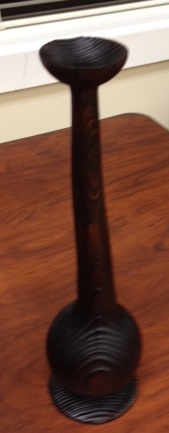
Tom Gaston made two candlesticks by turning, then carving Douglas fir and blackening it by burning.
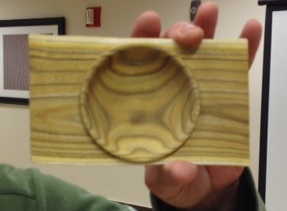
Claude Goldcharles presented sumac turnings.
A Blast From The Past
(or A shaving of BAWA history)
The November, 1988, meeting was held at The Splinter Group, a woodworking cooperative in Berkeley. The conversation centered around the group's operations. Members discussed their particular roles, handling of accounts and inventories, sharing of tools, and so on. There was also a presentation by Woody Woodward (I did not make that up) about his approach to jig construction and his focus on both accuracy and safety.
In more business-related news, election of club officers was announced, although the position of secretary was left open for nominations and election at the December meeting. The person responsible for writing the newsletter, citing increased time pressure from her business, accepted the position on the condition that an assistant editor be chosen. They were looking for someone with a computer and a desktop publishing program to further improve the newsletter.
There was a very nice note from the volunteer projects coordinator, saying that, thanks to the many BAWA members who volunteered their time (among other volunteers and donors), the Larkin Street Youth Center will be able to build a new drug abuse center, medical clinic, classroom and street outreach offices.
The Wood of the Month was Bird's eye maple. The story included a discussion about the fact that no one knows what causes the bird's eye phenomenon. Explanations ranged from it being a result of stunted growth due to trees being crowded or deprived of sunlight to the result of a genetic defect or disease. Interestingly, 30 years later we still don't know what causes it.

And most importantly, RSVP's for the second annual BAWA Christmas dinner were due no later than Tuesday, December 6th, so they could know how many turkeys to buy and tables to set.
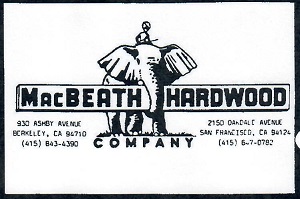
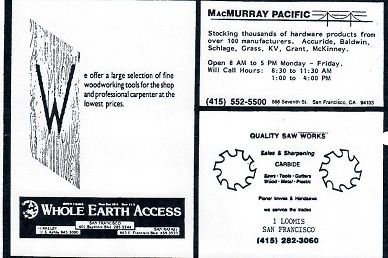
Note: The newsletters pages were scattered with ads which were provided revenue to help fund the postage etc.
Jon Kaplan
Stephen RosenblumSecretary steve@rosenblums.us
